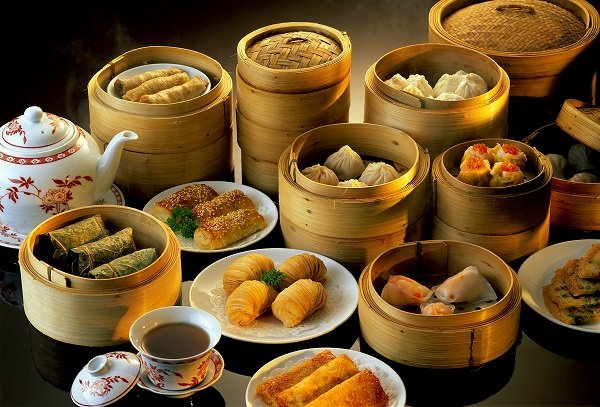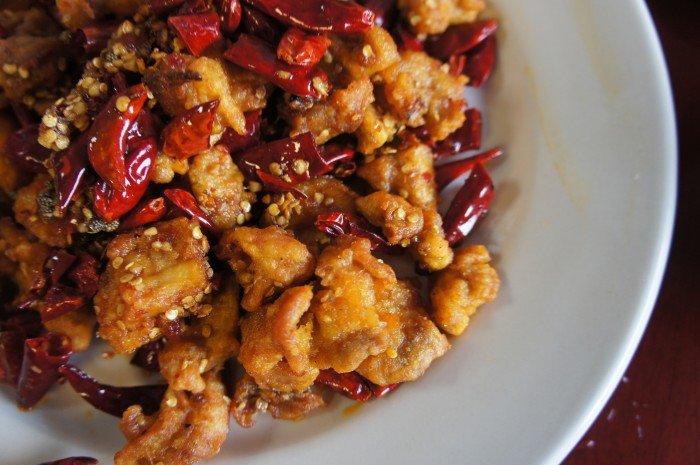

Dim sum – typical Cantonese regional cuisine
1. Diversity: There are 8, some argue 9, distinct regional cuisines in China. These have been grouped into 4 schools of cooking, each with very distinct flavors, use of ingredients and style of cooking. They can be categorized in the following way: North – this is the cuisine of Beijing, Inner Mongolia and imperial Shandong which features heavy use of leeks and onions and includes stewing and roasting techniques (think Peking roast duck). West – This is where the spiciest food of China originates (Sichuan), with the stir-fry cooking favoring the use of chilies, garlic and ginger. East – More use of steaming and lighter flavors with soy sauce and rice wine. South – Cantonese is the best-known outside of China including sweet and sour flavoring and lightly flavored dim sum. As China is such a huge country and the cuisine from each region so varied it would take months if not years to try all the different dishes China has to offer. Aim to try a few dishes from each school to understand the different flavors and techniques used, and to find which regional cuisines suit your taste buds.
2. Vegetables: One of the surprising things about Chinese food in China is just how many types of vegetables you see served. Lots of the cuisine here is extremely healthy and actually far less oily than in Chinese restaurants overseas. You get a lot of cold salads on the menus such as pai huang gua – 拍黄瓜 (smashed cucumber with garlic) and liangban mu er – 凉拌木耳 (wood ear mushrooms with raw onion and chili). There are many vegetables in China that you are unlikely to have seen before but which you should most certainly try. Ones to look out for are bitter melon (ku gua – 苦瓜 – as bitter as it sounds), winter melon (dong gua – 冬瓜), dragon beans (long dou – 龙豆) and celtuce (wo sun – 莴笋). Yunnan food especially uses very interesting and unique ingredients such as a wonderful dish using jasmine flowers fried with eggs. But even simple dishes such as broccoli fried with garlic taste wonderful in China – juicy and crunchy and much tastier than how it is typically cooked in the west. Eggplant is also especially creamy and tasty in Chinese dishes so worth looking out for.

Spicy Chongqing la zi ji
3. Street Food: Although not as famous as that of southeast Asia, street food in China is still good. If you love street food then you should definitely visit Xi’an. Head to the Muslim Quarter near the Great Mosque and feast on lamb skewers sprinkled with cumin (yangrou chuan – 羊肉串); Uighur flat breads (kao nang – 烤馕); roujiamo – 肉夹馍 (a kind of sandwich filled with pork and cilantro); and bowls of thick, steaming noodles (try daoshaomian – 刀削面 and biangbiang mian – the character for biang is so complicated that it cannot even be typed on a computer!). Hong Kong also has great street food but you are best off braving the queues and going during lunch time on a weekday when all the office workers ensure things are kept fresh.
4. Spice: If you like spicy food forget India, China is where things really hot up! Sichuan and Hunan cuisine are the spiciest by a long way. Sichuan even has its very own spice – Sichuan pepper (hua jiao – 花椒) which has a numbing but buzzing effect on the mouth, it’s quite unique and certainly a must try! Chengdu is the mecca for spicy food in China, although you can find decent Sichuan restaurants throughout the country. The very fiery dishes are Chongqing la zi ji – 重庆辣子鸡 which is chicken fried with no small amount of chili; shao chao rou – 少炒肉 which is sliced pork fried with scallions and chili; mala xiangguo – 麻辣香锅 – a pot of vegetables and meat mixed together with chili and Sichuan peppercorns; and hotpot (huoguo – 火锅). The best hotpot places are the ones where you can choose the level of spice – spice fiends should go for ‘te la’ – 特辣 (very spicy) and if you like your spice but can’t quite handle a vindaloo then go for ‘wei la’ – 微辣 which is still very spicy – you have been warned!
Despite China being a nation obsessed with food, there are a surprising number of mediocre restaurants around so you should try and do your research on where to go before heading for dinner. If you come to China with Imperial Tours then let our China Host or virtual concierge know that you want to try particular types of Chinese food so that they can make restaurant recommendations based on this. You will also receive a list of restaurants with our personal recommendations from each menu. If you travel with a China Host then this adds an additional level of service for the foodie traveler because the Host is constantly refining the restaurants you visit and re-tuning the menus based on your tastes. Foodies may be interested in attending Hong Kong’s annual Wine & Dine Month in October and Shanghai Park Hyatt’s Food & Wine Festival in November – we can customize tours around these events We can also arrange cooking classes for those who want to hone their culinary skills in a Chinese kitchen. You can start to plan your itinerary here.
For further foodie reading you can check out the links below:
http://imperialtours.net/blog/misconceptions-about-dining-china